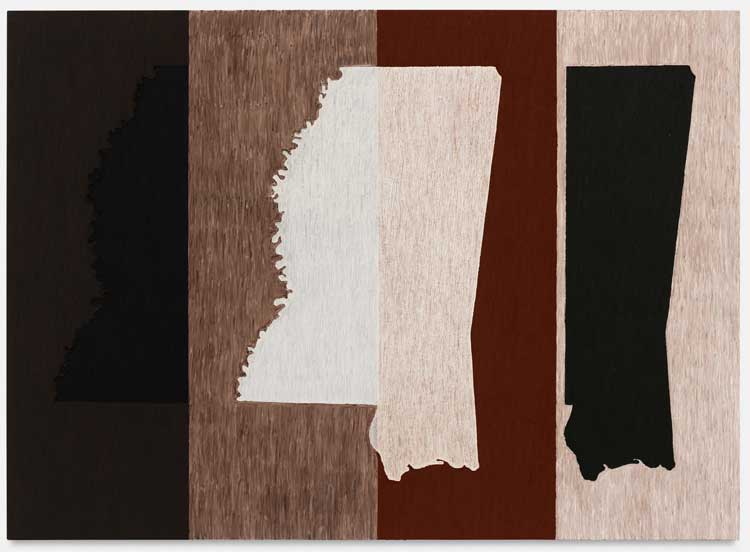.jpg)
McArthur Binion, Visual:Ear, 2023 (detail). Ink, paper and paintstick on board, 182.9 x 121.9 x 5.5 cm (72 1/8 x 48 x 2 1/4 in). Courtesy the artist and Xavier Hufkens.
Xavier Hufkens, Brussels
16 January – 8 March 2025
by ALLIE BISWAS
There are two focal points in this exhibition of 30 paintings, nearly all of which were made by McArthur Binion between 2014 and 2024. The first is a painting from 1985, which at its centre features a minuscule photograph of the house where Binion was born, in 1946. This is positioned as the exhibition’s opening work. The second is the artist’s spiral-bound address book presented later on, upstairs, in a glass cabinet, which dates from 1973, Binion’s last year at graduate school, to 1991, the year he moved to Chicago. Initially appearing as outliers, this group of two embodies the underlying principle of Binion’s art, which could be summed up by something he said in a 2022 interview: “I’m really pointing to the origin.”
-For-Three-Movements-of-Sunlight-2014.jpg)
McArthur Binion, Sketch (Looking for Grey):For:Three Movements of Sunlight, 2014. Paintstick, ink and paper on board, 121.9 x 81.3 x 5.7 cm (48 x 32 1/8 x 2 1/4 in). Courtesy the artist and Xavier Hufkens.
At first sight, it would be easy to read Binion’s paintings as minimalist compositions due to their obvious dependency on the grid format – canvases that have been precisely divided up into a symmetrical network of squares of varying sizes (though the artist’s palette is far from restrained and pattern also plays a significant part). A selection of new paintings from a series titled Visual: Ear, which was instigated in 1971 when Binion, as a student, was attempting to create images of the music he listened to, from a distance look like multicoloured patchwork quilts or walls of finely patterned chequerboard tiles. Looking closeup at the surface of each painting, one finds musical scores that have been collaged on to the canvas within each square, just about visible underneath Binion’s brushmarks, as well as tiny, photocopied portraits of corresponding jazz musicians that are used as the painting’s border. These are Binion’s favourites: Ornette Coleman, John Coltrane and Cecil Taylor. This layer underneath the painting, what the artist calls the “under conscious”, corrects any minimalist claims, but Binion’s touch is so unobtrusive that what he tells us about himself fortunately remains somewhat elusive.
-2024.jpg)
McArthur Binion, Visual:Ear(Sound Grammar), 2024. Graphite, ink, paintstick and paper on board, 213.4 x 213.4 x 5.5 cm (84 1/8 x 84 1/8 x 2 1/4 in). Courtesy the artist and Xavier Hufkens.
That painting from 1985 (Modern:Ancient:Brown) was the first time that Binion had used a recognisable image in a painting. He would continue to make reference to photographs of his childhood home in Macon, Mississippi, before adding his birth certificate to the mix, along with pages from his address book. It is this group of three sources that constitutes Binion’s “under conscious” – his way of centring on some sort of biography, on his essence, through abstract painting.
In 2013, the artist rediscovered an old address book that corresponded with the people he knew during the 20 years he lived in New York. These handwritten names and phone numbers can just about be made out below the surface in studies from the ongoing DNA series displayed here: vibrant monochromatic grids of crimson-orange or emerald green that obscure copies of pages from the book that have been assembled in vertical and horizontal patterns. Binion recalls how he “relived every day of my life” during the months that these paintings were made.

McArthur Binion, Haints, 2014. Paint stick and wax crayon on board, 116.8 x 162.6 x 6.8 cm (46 x 64 1/8 x 2 3/4 in). Courtesy the artist and Xavier Hufkens.
The Haints series, which Binion began in 2014, is exhibited here for the first time. Taking its title from an alternative spelling of “haunt”, used by African Americans to describe ghosts or restless spirits, these paintings explore the artist’s upbringing in the American south through painted shapes of maps documenting Mississippi, which Binion has reversed. These compositions abandon the bright, mesh-like quality that the other paintings embrace, instead foregrounding stark shapes in black and white that are surrounded by a plain background. They also forego the usual substrate relied on by Binion. But the abstraction nevertheless speaks for itself. As the artist has said of these sharply delineated images: “They are larger self-portraits about who I am and how I live – all the information is there.”